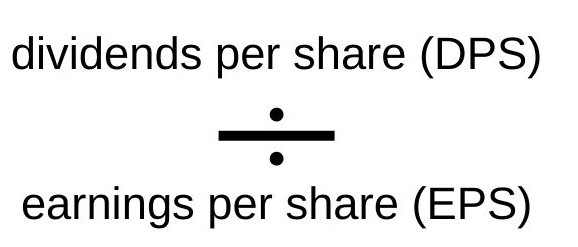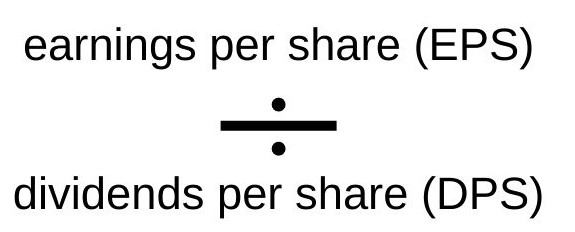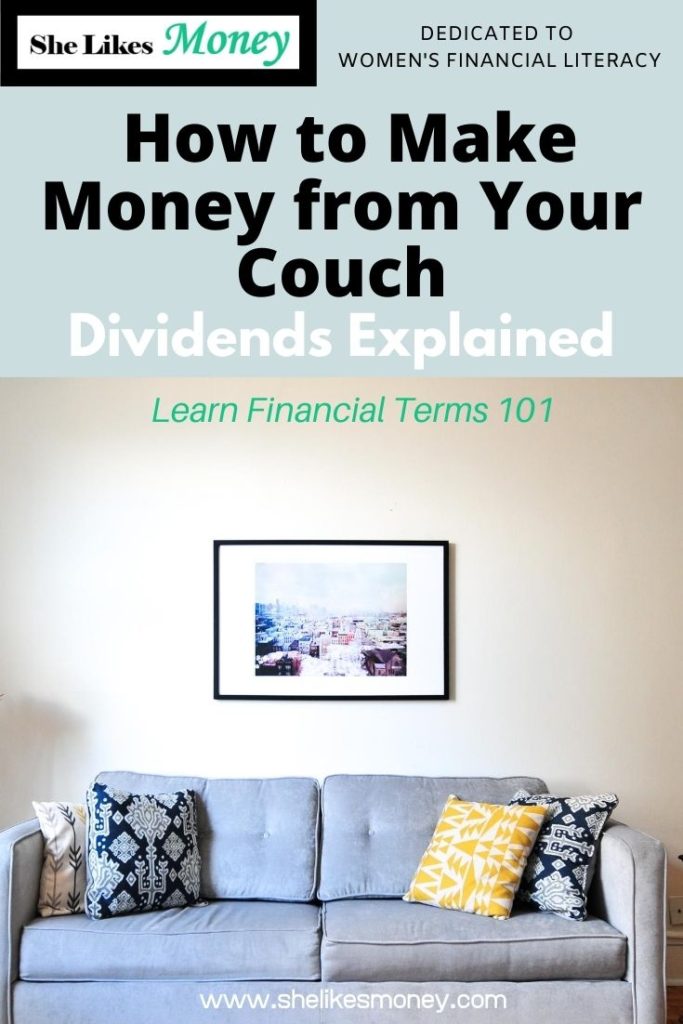
Dividends = Passive Income
Getting paid is really really nice.
It’s Friday, it’s been a long week, you plop on the couch, put your feet up. Then, *ding!* you have a notification that your paycheck has just been deposited. Money! You smile and close your eyes. The endless week suddenly feels less exhausting.
Now imagine that happening without you having to work. Ha, ha, yeah, that’s a dream world. Getting paid without doing any work.
Well, that’s what dividends are.
Dividends Explained: Table of Contents
- What are Dividends?
- Picking Stocks Based on Dividends
- How Big Are Dividends?
- How Dividends Affect Stock Prices
- How Can I Find Stocks that Pay Dividends?
- Three Important Dividend Valuation Ratios
- A Quick Word About Mutual Fund & ETF Dividends
- Why We Like Dividends
- Why We Don’t Buy Stocks Purely Based On Dividends
- Handy Dividend Terms
- RECAP
What Are Dividends?
Dividends are like loyalty rewards for shareholders. For every share of stock you own, you could receive a cash dividend or, less common, a stock dividend.
Dividends are paid through retained earnings – aka the profit left over after all company expenses have been paid for. Retained earnings get reinvested back into the company to grow the business. But, if a company wants, they can use a portion of the retained earnings to give shareholders a money-flavored hug.
Paying dividends is optional and doesn’t have to be regular or happen at all. Sometimes, if a company has an especially profitable quarter or other special circumstance, they will pay shareholders a special dividend. Surprise! On the other hand, if a company cuts its regular dividend payment, it might be a sign of cash shortages.
Big profitable companies dish out dividends for a couple reasons:
- Make their stock desirable. Like a rich uncle, they’ll throw money at you to win your heart.
- Show how reliable they are. Sometimes companies will pay dividends even when profits are sub-par. They do this to show consistency. If companies skip dividend payments, shareholders’ loyalty might wan
Some companies are known for consistently handing out regular dividend payments. These tend to be businesses in established, profitable industries like utilities, banks and financial institutions, oil and gas, and material companies like steel and chemicals. If a company is what’s known as a “dividend aristocrat”, they are part of an elite group of S&P 500 stocks with a history of 25+ years of dividend increases. They also own dogs named Duke or Lord Rothschild.

Picking Stocks Based on Dividends
Dividends are great for being rewarded as a shareholder but could hinder growth. Why? Money used to pay dividends means less money reinvested in the company. More money back in = more growth.
It’s like if you’re debating whether to save more per month or move to a bigger, more expensive apartment. Aka weighing savings growth vs. today’s comforts.
If a young, high-growth company offers dividends, stock analysts scratch their heads thinking, it couldn’t find better ways to spend that money? High-growth companies also don’t tend to have the consistent earnings dividends require. Most tech stocks don’t offer dividends because they are primarily focused on growth. Older companies with very steady earnings are more likely to pay dividends.
Okay, How Big Are Dividends?
Dividend amounts vary. To give you an idea, the asset manager BlackRock (BLK) paid the largest dividend on a per share basis in 2018 of $2.88 per share. Keep in mind that the per share dividend amount depends on how many shares of stock the company has outstanding.
However, the monetary dividend amount isn’t all that’s important. We also have to think about how much we’re paying to own the stock.
To calculate the “value” of a company’s dividend, we use what’s called the dividend yield.
Dividend yield: Annual dividend divided by share price
The dividend yield tells us the percent of dividends stockholders receive compared to the price of the stock. Since we want to receive large dividends and pay little for them, we like large dividend yields. But again, remember that the higher the dividend, the less money being reinvested into the company.
Another tricky thing with dividend yields: stock prices are always changing, whereas dividends are usually announced every quarter. If a company struggles for several quarters in a row, its stock price could plummet, but the dividend amount would still look fine. With a low stock price and high dividend, the dividend yield would look really high! But only because the data doesn’t accurately reflect the company’s struggles.
While the dividend yield can be a useful metric, don’t buy a stock just because the dividend yield is high.
How Dividends Affect Stock Prices
It makes sense that companies that pay regular dividends would be well-liked. Handing out free money = more popularity.
When a company announces it is increasing its dividend payment that quarter, the stock price will typically spike upwards, a result of the market pricing in the future dividend increase. Once the dividend has been paid (called the ex-dividend date) the price will likely drop to reflect the reduced dividend value.
When a company announces a reduction or cut in dividend payments, stock prices will usually fall.
The reduced or cut dividend could be a well-thought strategy or a reflection that times are tough and the company is tightening its wallet. Since the market tends to be persuaded by headlines alone, it’s up to you, as the investor, to investigate whether the dividend change matters or not.
How Can I Find Stocks that Pay Dividends?
There are plenty of lists all over the internet and popular financial news websites that show the companies that pay dividends.
To find out if a stock pays dividends, here are two easy methods to look it up:
- Google the stock ticker or the company’s name + “stock”. For example, if I wanted to see Apple’s dividend, I would Google “APPL” or “apple stock.” Some quick highlights of the stock will pop up, including the dividend yield, shortened to “div yield.” If there’s no percentage listed, the company does not offer a dividend.
- Go to finance.yahoo.com and type the stock ticker or company name into the search book. On the “Summary” tab, in the second column to the left of the price chart, you’ll see the Forward Dividend & Yield, and below that, the Ex-Dividend Date.
To find companies that pay dividends, it’s simply a matter of research. One popular list, called “The Dogs of the Dow,” lists the highest dividend yield stocks of the Dow Jones Index. You can also find lots of other dividend lists there, like the highest dividend-paying stocks on major US stock exchanges.
Three Important Dividend Valuation Ratios
To figure out if a dividend-paying stock is financially healthy, we can use these four ratios (#mathtime) to uncover some sneaky stock secrets. They can help us figure if the dividend good-times will last in the long-term.
Dividend Payout Ratio

This ratio tells us how much earnings the company is using to pay its dividend. In most cases, a good dividend payout ratio is under 50%. A company dedicating too much in earnings to pay dividends looks unstable to investors.
Dividend Coverage Ratio

Dividend payout ratio but flip it upside down = dividend coverage ratio. This tells us how many times over the company’s earnings could cover its dividend payments. Generally, a dividend coverage ratio of 2 or higher is what we want here.
Total Shareholder Return

Okay, okay, don’t let your eyes glaze over just cause this ratio is longer.
This is a handy calculation to use when you are deciding whether or not to sell a dividend stock you already own. It shows you how much return a stock gave you over the past year.
A quick example: We bought one share of Dog-Cat Company stock for $100. At year end, the stock price is at $120. It pays a dividend of $0.50 per share. We’re debating whether to sell it or not.
To help us decide, we calculate our total shareholder return:
(120 – 100 + 0.50) / 100 = 20.5%
Our investment gained a return of 20.5%! That’s awesome. We decide Dog-Cat Company is headed for even better returns next year, so we don’t sell. (Duh, as if we’d sell. Dog-Cat Company is the future, yo.)
A Quick Word About Mutual Fund and ETF Dividends
This whole post we’ve been talking about stocks. But we’d be REMISS if we didn’t discuss dividends for mutual funds and ETFs. REMISS WE TELL YOU.
Mutual funds and ETFs are assets made up of stocks. When the funds that own these stocks get paid dividends, the fund must distribute them to their shareholders, aka the people who bought shares of the mutual fund or ETF.
To limit the administrative costs of paying out the dividends to the mutual fund’s shareholders, the dividend payments might be held and distributed only annually or semiannually.
As a fund shareholder, you can choose what you want to do with your dividend payout. You can keep it as cash in your investment account. Or you can reinvest it into the fund to buy more shares. If you’re saving for retirement, dividend reinvestment is a great option to help your investments grow.
You could also use your dividends to buy shares of a different fund.
Why We Like Dividends
- Passive income
- Can be used to buy more stock, meaning more potential gains for you
Why We Don’t Buy a Stock Purely for Dividends
- Dividends and dividend yield don’t necessarily indicate a stock’s value
- Not an indicator of company performance
Handy Dividend Terms
Announcement Date: Think Save the Date. When a company announces it’s paying a dividend and how much.
Ex-dividend Date: Last chance for rewards. If you buy a stock on or after the ex-dividend date, you don’t receive the dividend. Conversely, if you sell after the ex-dividend date, you’ll still get the dividend.
Payment Date: Payday! Date the dividend gets credited to the stockholder’s account.
Form 1099-DIV: A fun little tax form that tells you all your passive income earnings for the year. You’ll get this form for dividends paid by individual stocks, mutual funds, ETFs, REITs, etc.
RECAP
Dividends are payments companies make to shareholders. They can be in the form of money, stock, or something else. For each share of stock you own, you get one dividend payment.
When looking at stock data, you’ll see a term called the “dividend yield.” This is the ratio of how much annual dividend you get for the price of one stock.
Dividends help your money grow faster if you reinvest them. Leaving you more time to ponder life and hang out on your couch.




